
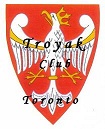
TROYAK EXECUTIVE TEAM is informing all members, colleagues, collectors, and Polonia at large, that Club meetings taking place at John Paul II Polish Cultural Centre, 4300 Cawthra Rd. (just south of Hwy. 403), Mississauga, Ontario. The new members are always welcome. www.polishculturalcentre.ca
ADRES SPOTKAÑ KLUBOWYCH ! Zarząd Główny Klubu “Troyak” informuje wszystkich członków kolekcjonerów, sympatyków oraz całą Polonię, że spotkania klubowe odbywają się w Polskim Centrum Kultury im. Jana Pawła II, przy 4300 Cawthra Rd. (na południe od autostrady 403), Mississauga, Ontario. Zapraszamy nowych członków do prężnego. Klubu “Troyak”. www.polishculturalcentre.ca

“TROYAK” CLUB NEXT MEETINGS …
NASTĘPNE SPOTKANIA KLUBU “TROYAK” …
Sunday 25th February 2024 @ 4:30 p.m.
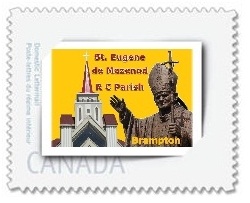
Sunday – 3rd March 2024 @ 9:00 a.m. to 4:00 p.m.
Mississauga Coin & Stamp Show
24th March 2024 @ 4:30 p.m.

28th April 2024
26th May 2024; 30th June 2024
July & August 2024 – Summer break … Letnie wakacje …
29th September 2024; 27th October 2024
24th November 2024
December 2024 … Happy Holidays!


Święto Sztabu Generalnego Wojska Polskiego
www.poczta-polska.pl
W dniu 25 października 2023 r. została wprowadzona do obiegu kartka pocztowa z nadrukowanym znakiem opłaty pocztowej, emisji: Święto Sztabu Generalnego Wojska Polskiego.Wartość nominalna znaku opłaty pocztowej z oznaczeniem literowym A odpowiada wartości nominalnej znaczka pocztowego używanego do uiszczenia opłaty za ekonomiczną przesyłkę listową nierejestrowaną, w tym kartkę pocztową, w obrocie krajowym, w formacie S. W prawym górnym rogu strony adresowej kartki nadrukowano znak opłaty pocztowej, na którym przedstawiono wizerunek Szefa Sztabu generała Tadeusza Jordana – Rozwadowskiego na tle Pałacu Saskiego; wzdłuż dolnej krawędzi napis: POLSKA a w prawym górnym rogu oznaczenie wartości: A.
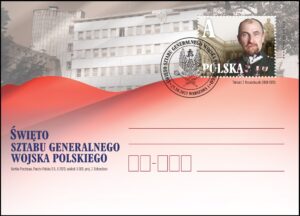
W części ilustracyjnej kartki przedstawiono budynek będący obecnie siedzibą Sztabu Generalnego Wojska Polskiego. W dolnej części kartki umieszczono nazwę emisji ,,ŚWIĘTO SZTABU GENERALNEGO WOJSKA POLSKIEGO”. Kartkę o wymiarach 148 x 105 mm wydrukowano jednostronnie, techniką offsetową, na kartonie białym, w nakładzie 5000 sztuk. Autor projektu kartki: Jarosław Ochendzan.

X Międzynarodowy Zlot Kolekcjonerów
www.poczta-polska.pl
W dniu 28 października 2023 r. została wprowadzona do obiegu kartka pocztowa z nadrukowanym znakiem opłaty pocztowej, emisji: X Międzynarodowy Zlot Kolekcjonerów. Wartość nominalna znaku opłaty pocztowej z oznaczeniem literowym A odpowiada wartości nominalnej znaczka pocztowego używanego do uiszczenia opłaty za ekonomiczną przesyłkę listową nierejestrowaną, w tym kartkę pocztową, w obrocie krajowym, w formacie S. W prawym górnym rogu strony adresowej kartki nadrukowano znak opłaty pocztowej, na którym umieszczono medal okolicznościowy ze zbiorów Muzeum Monet i Medali Jana Pawła II w Częstochowie; wzdłuż lewej krawędzi znaczka umieszczono napis: POLSKA i oznaczenie wartości: A.
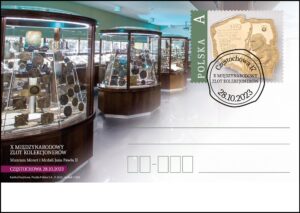
W części ilustracyjnej kartki przedstawiono gabloty z eksponatami z sali wystawienniczej w Muzeum Monet i Medali Jana Pawła II w Częstochowie; w lewym dolnym rogu kartki umieszczono napis: X MIĘDZYNARODOWY ZLOT KOLEKCJONERÓW, Muzeum Monet i Medali Jana Pawła II, CZĘSTOCHOWA 28.10.2023. Kartkę o wymiarach 148 x 105 mm wydrukowano jednostronnie, techniką offsetową, na kartonie białym, w nakładzie 3000 sztuk. Autor projektu kartki: Poczta Polska S.A.

Bogusław Polch – rysownik
www.poczta-polska.pl
W dniu 30 października 2023 r. została wprowadzona do obiegu kartka pocztowa z nadrukowanym znakiem opłaty pocztowej, emisji: Bogusław Polch – rysownik. Wartość nominalna znaku opłaty pocztowej z oznaczeniem literowym A odpowiada wartości nominalnej znaczka pocztowego używanego do uiszczenia opłaty za ekonomiczną przesyłkę listową nierejestrowaną, w tym kartkę pocztową, w obrocie krajowym, w formacie S. W prawym górnym rogu strony adresowej kartki nadrukowano znak opłaty pocztowej, na którym umieszczono zdjęcie Bogusława Polcha, w prawym górnym rogu znaczka oznaczenie wartości: A oraz napis: POLSKA, a wzdłuż lewej krawędzi napis: Bogusław Polch.
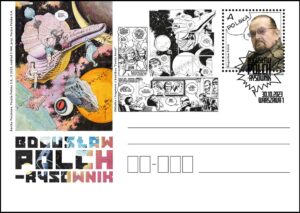
W części ilustracyjnej kartki przedstawiono okładkę i fragmenty z komiksu ,,Funky Koval”, a w części dolnej kartki napis: BOGUSŁAW POLCH – RYSOWNIK. Kartkę o wymiarach 148 mm x 105 mm wydrukowano jednostronnie, techniką offsetową, na kartonie białym, w nakładzie 5 000 sztuk, w następujących kolorach druku: żółtym, czerwonym, niebieskim i czarnym. Materiał do projektu kartki i współpraca merytoryczna: córki Pana Bogusława Polcha: Pani Patrycja oraz Pani Paulina. Autor projektu kartki: Poczta Polska S.A.

75 lat Zespołu Mazowsze
www.poczta-polska.pl
W dniu 8 listopada 2023 r. został wprowadzony do obiegu znaczek pocztowy o wartości 3,90 zł emisji “75 lat Zespołu Mazowsze”. Na znaczku przedstawiono tancerkę z zespołu ,,Mazowsze” w stroju ludowym. Znaczek wydrukowano techniką offsetową, na papierze fluorescencyjnym, w formacie: 40,5 x 40,5 mm, w nakładzie 135 000 sztuk. Arkusz zawiera 5 szt. znaczków i przywieszkę. Z tej okazji została wydana również koperta FDC. Autor projektu: Roch Stefaniak.
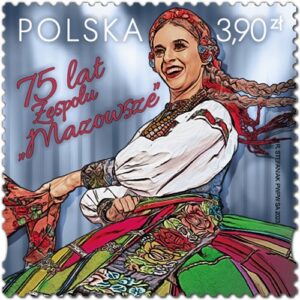
W uroczystej atmosferze jubileuszu 75-lecia istnienia Zespołu Ludowego Pieśni i Tańca „Mazowsze” Poczta Polska wprowadziła do obiegu znaczek poświęcony rodzimemu dziedzictwu kulturowemu, które członkowie zespołu pielęgnują i promują od 1948 roku. Przez lata zdobyli również uznanie na międzynarodowej scenie jako jeden z największych na świecie zespołów artystycznych.
W arkuszu pięciu znaczków autor projektu, Roch Stefaniak, przedstawił jedną z tancerek zespołu „Mazowsze” prezentującą się w malowniczym stroju ludowym. Arkusz uzupełnia przywieszka z logotypem obchodów 75-lecia istnienia Zespołu. Wraz z emisją Spółka wyemitowała również kopertę Pierwszego Dnia Obiegu FDC, na której umieszczono barwną grafikę tańczącego na scenie „Mazowsza”, któremu towarzyszy orkiestra symfoniczna zespołu. Całość wydawnictwa filatelistycznego dopełnia datownik ukazujący parę tancerzy.
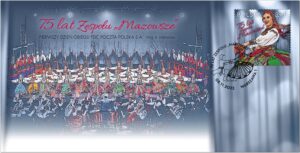
Dziedzictwo Zespołu „Mazowsze” … „Mazowsze” od 75 lat promuje polski folklor ukazujący się w postaci widowiska muzycznego zawierającego elementy muzyki i tańca. To niezaprzeczalny element polskiego dziedzictwa kulturowego. Pełni nie tylko funkcję zespołu artystycznego, lecz także istotnego promotora bogactwa polskiej tradycji ludowej. W swoich przedstawieniach ukazuje bogactwo regionalnych tradycji przekazywanych przez barwne stroje, dźwięki ludowych instrumentów i energetyczne tańce. Działalność „Mazowsza” jest wyrazem patriotyzmu. Podkreśla piękno polskiej kultury, jednocześnie budując więź między współczesnym społeczeństwem a tradycją i inspirując do pielęgnowania własnych korzeni oraz kształtowania poczucia narodowej dumy.
To nie pierwsza inicjatywa promująca działalność Zespołu „Mazowsze” … W czerwcu br. Poczta Polska rozpoczęła uroczyste obchody powstania Zespołu „Mazowsze” poprzez wydanie pierwszej kartki okolicznościowej emisji „75 Mazowsze Ambasador Kultury Polskiej”. Grafika, która pojawiła się w projekcie waloru, prezentowała parę tancerzy zespołu „Mazowsze”. W 2022 r. Spółka wprowadziła do obiegu kartkę okolicznościową „Rodzinny piknik z Zespołem Mazowsze”, którą miała przyjemność zaprezentować na stoisku filatelistycznym podczas pikniku odbywającym się w zabytkowym parku Karolin w Otrębusach. Warto nadmienić, że w 2017 roku wydawnictwo „Mazowsze Śpiewnik Kolęd i Pastorałek”, sprzedawane wyłącznie w sieci placówek Poczty Polskiej, osiągnęło status Złotej Płyty. Uzyskanie wyróżnienia oznacza, że łącznie Poczta Polska sprzedała co najmniej 15 tys. egzemplarzy płyt za pośrednictwem własnej sieci sprzedaży.

350. rocznica bitwy pod Chocimiem
www.poczta-polska.pl
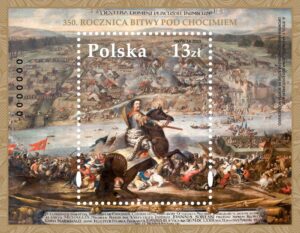
W dniu 11 listopada 2023 r. został wprowadzony do obiegu znaczek pocztowy w formie bloku o wartości 13,00 zł, emisji “350. rocznica bitwy pod Chocimiem”. Na znaczku przedstawiono zdjęcie obrazu A. Stecha i F. Van Kessela ,,Bitwa pod Chocimiem, 1673″ pochodzącego ze zbiorów Lwowskiej Narodowej Galerii Sztuki im. Borysa Woźnickiego. Znaczki wydrukowano techniką offsetową, na papierze fluorescencyjnym.
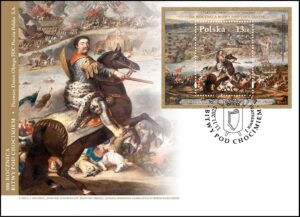
Format znaczka: 39,5 x 51 mm. Format bloku: 90 x 70 mm mm. Nakład bloku: 88.000 sztuk perforowanych i 2 000 szt. nieperforowanych. Autor projektu znaczka: Joanna Fleszar – Haspert. Z tej okazji została wydana koperta FDC. W związku z tą emisją są oferowane również inne formy wydawnicze z kryptowalorami, które są udostępnione w sprzedaży.

Franciszkański Zakon Świeckich
www.poczta-polska.pl
W dniu 17 listopada 2023 r. został wprowadzony do obiegu znaczek pocztowy o wartości 4,60 zł emisji “Franciszkański Zakon Świeckich”. Na znaczku zaprezentowano witraż przedstawiający św. Franciszka z tercjarzami – św. Elżbietą i św. Ludwikiem. Na dole znaczka umieszczono napis: Franciszkański Zakon Świeckich, a wzdłuż prawego brzegu, oznaczenie wartości: 4,60 zł i napis: POLSKA.
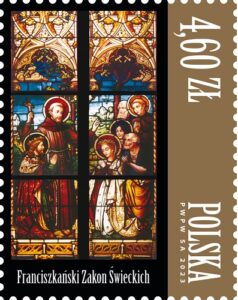
Emisji towarzyszy koperta FDC, na której zamieszczono zdjęcie obrazu przedstawiającego przekazanie zasad życia dla Franciszkańskiego Zakonu Świeckich przez św. Franciszka. Zarówno witraż, jak i obraz znajdują się w Klasztorze Franciszkanów we Wrocławiu – Karłowicach. W grafice datownika – znajduje się znak Tau, będący znakiem ruchu franciszkańskiego. Data 17 listopada to liturgiczne wspomnienie św. Elżbiety Węgierskiej – jednej z pierwszych tercjarek.
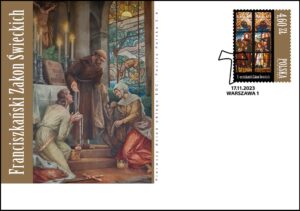
Emisja powstała we współpracy z wnioskodawcą – Franciszkańskim Zakonem Świeckich w Polsce. Znaczek wydrukowano techniką rotograwiurową, na papierze fluorescencyjnym, w formacie 31,25 x 39,5 mm, w nakładzie 100 000 szt., w następujących kolorach druku: niebieskim, żółtym, czarnym, czerwonym i złotym. Arkusz sprzedażny zawiera 50 znaczków. Autor projektu znaczka: Poczta Polska.

V Międzynarodowy Festiwal Muzyki
Europy Środkowo-Wschodniej
www.poczta-polska.pl
W dniu 17 listopada 2023 r. została wprowadzona do obiegu kartka pocztowa z nadrukowanym znakiem opłaty pocztowej, emisji: V Międzynarodowy Festiwal Muzyki Europy Środkowo-Wschodniej. Wartość nominalna znaku opłaty pocztowej z oznaczeniem literowym A odpowiada wartości nominalnej znaczka pocztowego używanego do uiszczenia opłaty za ekonomiczną przesyłkę listową nierejestrowaną, w tym kartkę pocztową, w obrocie krajowym, w formacie S.
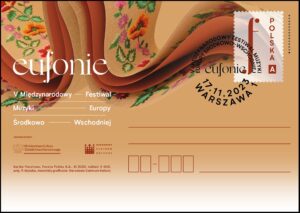
W prawym górnym rogu strony adresowej kartki nadrukowano znak opłaty pocztowej, na którym umieszczono znak graficzny Międzynarodowego Festiwalu Muzyki Środkowo-Wschodniej, natomiast w części ilustracyjnej, w tle całej kartki przedstawiono motyw graficzny – wstążki z motywem ludowym, w centralnej części kartki napis – nazwę festiwalu ,,eufonie” oraz tytuł emisji ,,V Międzynarodowy Festiwal Muzyki Środkowo-Wschodniej”. Kartkę o wymiarach 148 x 105 mm wydrukowano jednostronnie, techniką offsetową, na kartonie białym, w nakładzie 5000 sztuk. Autor projektu kartki: Paweł Myszka.

Ojciec Augustyn Kordecki –
bohaterski przeor i obrońca Jasnej Góry
www.poczta-polska.pl
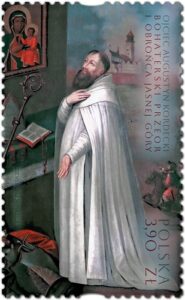
W dniu 18 listopada 2023 r. został wprowadzony do obiegu znaczek pocztowy o wartości 3,90 zł emisji “Ojciec Augustyn Kordecki – bohaterski przeor i obrońca Jasnej Góry”. Na znaczku przedstawiono wizerunek ojca Augustyna Kordeckiego. Wzdłuż prawej krawędzi znaczka umieszczono napisy: OJCIEC AUGUSTYN KORDECKI BOHATERSKI PRZEOR I OROŃCA JASNEJ GÓRY, POLSKA oraz oznaczenie wartości: 3,90 ZŁ.
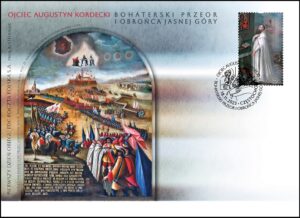
Znaczek wydrukowano techniką offsetową, na papierze fluorescencyjnym, w formacie: 31,25 x 51 mm, w nakładzie 128 000 sztuk. Arkusz zawiera 8 szt. znaczków. Z tej okazji została wydana również koperta FDC. Autor projektu: Roch Stefaniak.

Generał Kazimierz Sosnkowski (1885-1969)
www.poczta-polska.pl
W dniu 19 listopada 2023 r. został wprowadzony do obiegu znaczek pocztowy o wartości 3,90 zł emisji “Generał Kazimierz Sosnkowski (1885-1969)”. Na znaczku przedstawiono koloryzowaną fotografię Generała Kazimierza Sosnkowskiego. Na kopercie FDC umieszczono orzełka oraz wzory wężyków generalskich. Na datowniku umieszczono nazwę emisji oraz wzór wężyków generalskich. Opis zdjęcia ze zbiorów Pani Haliny Babińskiej, koloryzacja Mirek Szponar ( fot.1945 r. Montreal): Naczelny Wódz jest w mundurze typu brytyjskiego z polskimi guzikami z orłem w koronie i dystynkcjami generała broni na naramiennikach.
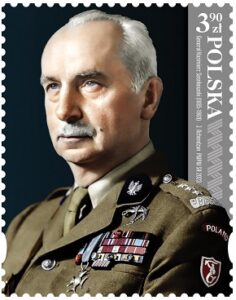
Nad lewą kieszenią honorowa odznaka pilota (tzw. gapa), wręczona Naczelnemu Wodzowi gen. Sosnkowskiemu przez dowódcę Polskich Sił Powietrznych gen. Mateusza Iżyckiego 26 maja 1944 roku. Poniżej baretki orderów, odznaczeń i medali polskich i zagranicznych, na nich zawieszony Krzyż Srebrny Orderu Wojennego Virtuti Militari V klasy. Na kieszeni odznaka I Brygady Legionów Polskich “Za wierną służbę”, którą ówczesny płk Kazimierz Sosnkowski otrzymał z rąk Józefa Piłsudskiego 6 sierpnia 1916 r. Na lewym rękawie naszywka Poland noszona przez żołnierzy Polskich Sił Zbrojnych pod dowództwem brytyjskim; niżej haftowana oznaka rozpoznawcza 2 Korpusu Polskiego w formie tarczy, na której znajduje się na czerwonym tle syrenka warszawska. dr. hab. Jerzy Kirszak Wojskowe Biuro Historyczne.
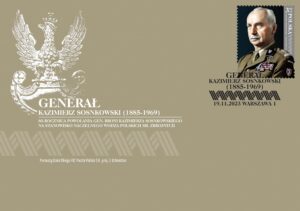
Emisja powstała przy współpracy z Wojskowym Biurem Historycznym, data wprowadzenia do obiegu jest dniem urodzin gen. K. Sosnkowskiego. Znaczek wydrukowano techniką offsetową, na papierze fluorescencyjnym,w formacie 39,5 x 31,25 mm, w nakładzie 144 000 sztuk w układzie tete-beche. Autor projektu znaczka: Jarosław Ochendzan.

100-lecie Związku Polaków w Belgii
www.poczta-polska.pl
W dniu 30 listopada 2023 r. została wprowadzona do obiegu kartka pocztowa z nadrukowanym znakiem opłaty pocztowej, emisji: 100-lecie Związku Polaków w Belgii. Wartość nominalna znaku opłaty pocztowej z oznaczeniem literowym A odpowiada wartości nominalnej znaczka pocztowego używanego do uiszczenia opłaty za ekonomiczną przesyłkę listową nierejestrowaną, w tym kartkę pocztową, w obrocie krajowym, w formacie S.
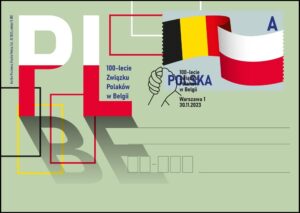
W prawym górnym rogu strony adresowej kartki nadrukowano znak opłaty pocztowej na którym umieszczono barwy narodowe Polski i Belgii, a wzdłuż dolnej krawędzi napis: POLSKA i w górnym prawym rogu oznaczenie wartości: A. W części ilustracyjnej kartki przedstawiono graficzne symbole literowe PL i BE wraz z napisem 100-lecie Związku Polaków w Belgii. Na datowniku przedstawiono dłonie złożone w geście współpracy. Nakład: 5 000 szt.; technika druku: offset; format kartki: 148 x 105 mm; liczba kartek: 1. Autor projektu kartki: Jan Konarzewski.


Odkryj Polskę – Gościkowo-Paradyż –
pocysterski zespół klasztorny
www.nbp.pl
Narodowy Bank Polski jest centralnym bankiem państwa odpowiadającym za politykę pieniężną i stabilność cen. Jego funkcje określa Konstytucja Rzeczypospolitej Polskiej i ustawa o NBP. NBP ma wyłączne prawo emisji pieniądza. Jako bank centralny nie prowadzi rachunków bankowych obywateli, nie przyjmuje od nich lokat, nie udziela kredytów. Prowadzi natomiast obsługę budżetu państwa, a także podmiotów sektora finansów publicznych. Gromadzi rezerwy walutowe państwa i zarządza nimi. Pełni funkcję banku banków, tworząc warunki do działania systemu bankowego. Jest również jednym z najważniejszych ośrodków naukowo-analitycznych w dziedzinie ekonomii i rynków finansowych.
Emisja wartości kolekcjonerskich stanowi okazję do upamiętniania ważnych historycznych rocznic i postaci oraz do rozwijania zainteresowań polską kulturą, nauką i tradycją. 8 listopada 2023 roku Narodowy Bank Polski wprowadził do obiegu monetę okolicznościową o nominale 5 zł z serii „Odkryj Polskę” – „Gościkowo-Paradyż – pocysterski zespół klasztorny”.
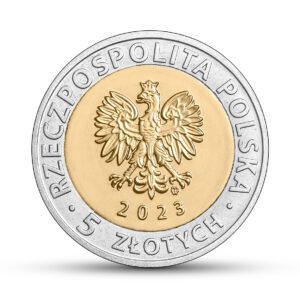
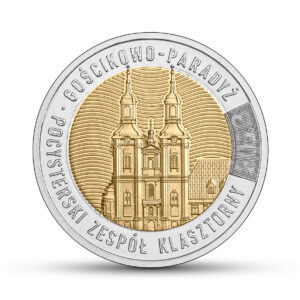
Nominał: 5 zł … stop: pierścień MN25, rdzeń CuAl6Ni2; stempel: zwykły; średnica: 24,00 mm; masa: 6,54 g; brzeg (bok): moletowany nieregularnie; na boku ośmiokrotnie powtórzony napis: NBP, co drugi odwrócony o 180 stopni, rozdzielony gwiazdkami; nakład: do 1 000 000 szt.; Projektantka awersu: Dobrochna Surajewska; Projektant rewersu: Paweł Pietras; Emitent: NBP; Na zlecenie NBP monety wyprodukowała Mennica Polska SA.
Historia klasztoru w Paradyżu rozpoczęła się 29 stycznia 1230 r., kiedy Mikołaj Bronisz, wojewoda wielkopolski, podarował zakonowi cystersów z brandenburskiego opactwa w Lehninie dziewięć wsi oraz osadę Gościkowo nad Paklicą. Zakonnicy przybyli na te tereny sześć lat później i nadali siedzibie nazwę Paradisus Matris Dei (Raj Matki Bożej). Wznieśli drewniane zabudowania wraz z kaplicą, a około 1250 r. rozpoczęli budowę murowanego kościoła, ukończoną w 1288 r. Wzniesiony w stylu gotyckim kościół został konsekrowany w 1397 r. W kolejnych latach opactwo stało się ważnym ośrodkiem życia intelektualnego. Było z nim związanych wielu uczonych, z których największą sławę zyskał Jakub z Paradyża, późniejszy profesor Akademii Krakowskiej. Umiejscowienie opactwa na zachodnich rubieżach kraju sprawiło, że klasztor miał również duże znaczenie polityczne. Przyczyniał się także do umacniania polskości tych ziem. O pozycji klasztoru świadczył też jego rozwój gospodarczy; na początku XVI w. paradyskie dobra liczyły ponad 29 tys. ha ziemi, 4 tys. ha lasów i 21 wsi.
Rozkwit opactwa zahamowała wojna trzydziestoletnia (1618–1648), w trakcie której stało się ono celem najazdów wojsk brandenburskich i szwedzkich. Zniszczeń dopełnił pożar, który wybuchł 10 kwietnia 1633 r. i objął zabudowania klasztorne oraz kościół. Do odbudowy klasztoru przyczynił się król Władysław IV, związany z Paradyżem osobą swojego wychowawcy, opata Marka Łętowskiego. W 1722 r. kolejny pożar strawił znaczną część zabudowań. Kościół przebudowano i nadano mu późnobarokowy charakter. Po drugim rozbiorze Polski Paradyż znalazł się w granicach państwa pruskiego, którego władze w 1796 r. skonfiskowały dobra klasztorne, a w 1834 r. zlikwidowały opactwo. W latach 1836–1926 w budynkach funkcjonowało Królewskie Katolickie Seminarium Nauczycielskie. Po II wojnie światowej obiekt został przekazany Kościołowi katolickiemu. Mieści się w nim siedziba Zielonogórsko-Gorzowskiego Wyższego Seminarium Duchownego i Sanktuarium Matki Bożej Wychowawczyni Powołań Kapłańskich. Informacja: ks. Dariusz Mazurkiewicz.

Discover Poland – The Post-Cistercian Monastery
Complex in Gościkowo-Paradyż
www.nbp.pl
Narodowy Bank Polski is the central bank of the State, responsible for its monetary policy and price stability. The Bank’s functions are described in the Constitution of the Republic of Poland and the Act on NBP. NBP holds the exclusive right to issue the currency of the Republic of Poland. As the central bank, it does not provide accounts for the general public, accept deposits from or extend loans to individuals. It acts as a banker to the State budget and public sector entities. NBP also holds and manages the foreign exchange reserves of the State. Finally, it functions as a banker to banks, creating conditions for the operation of the Polish banking system. Narodowy Bank Polski is one of the most important research and analytical centres in the fields of economics and financial markets.
Issuing collector items is an occasion to commemorate important historic figures and anniversaries, as well as to develop the interest of the public in Polish culture, science and tradition. On 8 November 2023, Narodowy Bank Polski issued into circulation a commemorative coin of the series “Discover Poland” – “The Post – Cistercian Monastery Complex in Gościkowo – Paradyż”, with a face value of 5 złoty.


Face value: 5 zł … Alloy: ring MN25, core CuAl6Ni2; Finish: standard; Diameter: 24.00 mm; Weight: 6.54 g; Edge (side): irregularly milled; on the edge: an inscription, NBP, repeated eight times, every second one inverted by 180 degrees, separated by stars; Mintage: up to 1,000,000 pcs; Obverse designer: Dobrochna Surajewska; Reverse designer: Paweł Pietras; Issuer: Narodowy Bank Polski; The coins, commissioned by Narodowy Bank Polski, were struck by Mennica Polska SA.
The history of the monastery in Paradyż began on 29 January 1230, when Mikołaj Bronisz, Voivode of Greater Poland, donated nine villages and the settlement of Gościkowo on the Paklica River to the Cistercian Order from the Brandenburg Abbey in Lehnin. The monks arrived in the area six years later and gave the settlement the name Paradisus Matris Dei (Paradise of the Mother of God). They erected wooden buildings including a chapel, and around 1250 they started the construction of a brick church, which was completed in 1288. The church, built in Gothic style, was consecrated in 1397. In the following years, the abbey became an important centre of intellectual life. Many scholars were associated with it, the most renowned of whom was James of Paradyż, later a professor at the Academy of Kraków.
The abbey’s location on the western fringes of the country meant that the monastery was also of great political importance. It also contributed to the strengthening of the Polish character of these lands. The monastery’s position was also reflected in its economic development. At the beginning of the 16th century, the Paradyż estate comprised over 29,000 hectares of land, 4,000 hectares of forests and 21 villages. The development of the abbey was halted by the Thirty Years’ War (1618-1648), during which it was raided by the Brandenburg and Swedish armies. The destruction was completed by a fire that broke out on 10 April 1633 and spread to the monastery buildings and church. King Ladislav Vasa, who was associated with Paradyż through his tutor, Abbot Marek Łętowski, contributed to the rebuilding of the monastery. In 1722, another fire consumed a large part of the buildings. The church was rebuilt in a late Baroque style.
After the second partition of Poland, Paradyż found itself within the borders of the Prussian state, whose authorities confiscated the monastery property in 1796 and liquidated the abbey in 1834. Between 1836 and 1926, the buildings housed the Royal Catholic Teachers’ Seminary. After the Second World War, the complex was transferred to the Catholic Church. It is now the seat of the Zielona Góra and Gorzów Seminary and the Sanctuary of Our Lady Carer of Priestly Vocations. Info: Fr. Dariusz Mazurkiewicz.

Skarby Stanisława Augusta – August III Sas
www.nbp.pl
Skarby Stanisława Augusta … Monety z wizerunkiem króla Augusta III Sasa są ostatnimi z serii „Skarby Stanisława Augusta” odwzorowującej słynną osiemnastowieczną serię medalierską z wizerunkami królów Polski wykonaną na zlecenie Stanisława Augusta Poniatowskiego. Seria „Skarby Stanisława Augusta” emitowana w latach 2013–2023 – tak samo jak ta stanowiąca jej pierwowzór – zakończy się emisją monet z wizerunkiem Augusta III Sasa.
Nominał: 500 zł … metal: Au 999,9/1000; stempel: zwykły; średnica: 45 mm; masa: 62,2 g; napis na obrzeżu: SKARBY STANISŁAWA AUGUSTA * AUGUST III SAS *; nakład: do 600 szt.; Projektant – Robert Kotowicz; Na zlecenie NBP monetę wyprodukowała Mennica Polska SA Emisja: 5 grudnia 2023 r.
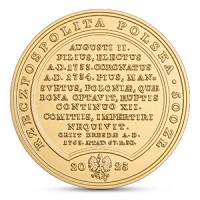
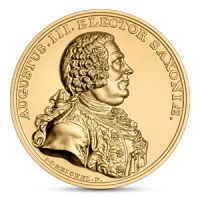
Syn Augusta II, wybrany Roku Pańskiego 1733, koronowany Roku Pańskiego 1734. Pobożny, łaskawy, Polski nie zdołał obdarzyć dobrami, których jej życzył, gdyż 12 sejmów zerwano pod rząd. Umarł w Dreźnie Roku Pańskiego 1763, mając lat 67, w 30 roku panowania, dnia 5 października.
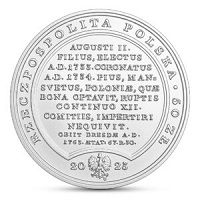
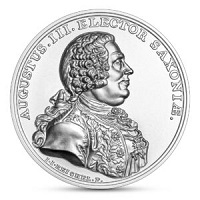
Nominał: 50 zł … metal: Ag 999/1000; stempel: zwykły; średnica: 45 mm; masa: 62,2 g; napis na obrzeżu: SKARBY STANISŁAWA AUGUSTA * AUGUST III SAS *; nakład: do 6000 szt.; Projektant – Robert Kotowicz; Na zlecenie NBP monetę wyprodukowała Mennica Polska SA Emisja: 5 grudnia 2023 r.
August III Sas (1733–1763) … Dwudziesta trzecia, ostatnia moneta serii medalierskiej przedstawia Augusta III, z dynastii Wettinów, od 1733 r. elektora saskiego (jako Fryderyk August II), w Polsce obranego na króla 5 października 1733 r. pod osłoną wojsk saskich i rosyjskich, koronowanego 17 stycznia 1734 r. w Krakowie. Równocześnie część szlachty wybrała na króla Stanisława Leszczyńskiego, skutkiem czego wybuchła wojna sukcesyjna zakończona kapitulacją zwolenników Stanisława. W 1736 r. odbył się sejm pacyfikacyjny, jedyny sejm niezerwany podczas panowania Augusta III. Polska, nie będąc stroną w wojnie siedmioletniej i wojennych konfliktach Saksonii z Prusami, cierpiała jako teatrum przemarszów obcych wojsk i traciła pozycję silnego państwa. Mimo to kraj przeżywał okres prosperity gospodarczej i rozwoju kultury. Na rewersie monety widnieje przeniesione z medalu popiersie króla (według obrazu Marcella Bacciarellego) w prawym profilu, w małej peruce z harcapem, w halsbandzie z żabotem spiętym agrafą, we fraku z bogatym haftem i z ozdobnymi guzikami, z szamerowanymi wyłogami oraz ze wstęgą Orderu Złotego Runa na szyi.
Na awersie monety czytamy tekst z rewersu medalu (w tłumaczeniu): Syn Augusta II, wybrany Roku Pańskiego 1733, koronowany Roku Pańskiego 1734. Pobożny, łaskawy, Polski nie zdołał obdarzyć dobrami, których jej życzył, gdyż 12 sejmów zerwano pod rząd. Umarł w Dreźnie Roku Pańskiego 1763, mając lat 67, w 30 roku panowania, dnia 5 października. Fryderyk August II, syn elektora saskiego i króla polskiego Augusta II oraz Krystyny Eberhardyny, urodził się w Dreźnie w 1696 r. jako kolejny elektor saski. Wychowywany w wierze luterańskiej przez babkę Annę Zofię, zdobył wykształcenie dworskie i odbył długą, ośmioletnią Grand Tour. By objąć tron polski, dokonał w 1712 r. konwersji na katolicyzm. Jego żona, arcyksiężniczka Maria Józefa Habsburg, zagorzała katoliczka, wspierała króla w jego polityce zagranicznej i działalności na polu kultury. Mieli 14 dzieci, które poprzez ożenki skoligowały się z wieloma dworami Europy. W polityce wewnętrznej August III lawirował między koteriami magnackimi, zdając się na decyzje ministra Henryka Brühla. Promował muzykę i operę, lubował się w wystawnych uroczystościach głównie w Dreźnie. Wzbogacił drezdeńskie zbiory sztuki. Rozbudował Zamek Królewski w Warszawie. Zmarł w Dreźnie w 1763 r. i tam został pochowany w katolickiej Katedrze Świętej Trójcy (Hofkirche). Informacja: Marta Męclewska.
Emisja wartości kolekcjonerskich stanowi okazję do upamiętnienia ważnych historycznych rocznic i postaci oraz do rozwijania zainteresowań polską kulturą, nauką i tradycją. Narodowy Bank Polski jest centralnym bankiem państwa odpowiadającym za politykę pieniężną i stabilność cen. Jego funkcje określa Konstytucja Rzeczypospolitej Polskiej i Ustawa o NBP. NBP ma wyłączne prawo emisji pieniądza. Jako bank centralny nie prowadzi rachunków bankowych obywateli, nie przyjmuje od nich lokat ani nie udziela kredytów. Prowadzi natomiast obsługę budżetu państwa, a także podmiotów sektora finansów publicznych. Gromadzi rezerwy walutowe państwa i zarządza nimi. Pełni funkcję banku banków, tworząc warunki do działania systemu bankowego. Jest również jednym z najważniejszych ośrodków naukowo- -analitycznych w dziedzinie ekonomii i rynków finansowych.

Treasures of Stanisław August – Augustus III
www.nbp.pl
Treasures of Stanisław August … The collector coins with the image of King Augustus III are the last coins of the series “Treasures of Stanisław August” reproducing the famous 18th century medallic series with the images of the kings of Poland, which was struck on the order of Stanisław August Poniatowski. The series “Treasures of Stanisław August”, issued from 2013 to 2023, will end – like the original series – with the issue of coins with the image of Augustus III.
Face value: 500 zł … metal: Au 999.9/1000; finish: standard; diameter: 45 mm; weight: 62.2 g; On the edge, the inscription: SKARBY STANISŁAWA AUGUSTA * AUGUST III SAS *; mintage: up to 600 pcs; Designer – Robert Kotowicz; Producer: Mennica Polska SA commissioned by NBP Date of issue: 5 December 2023.


Son of Augustus II the Strong, elected Anno Domini 1733, crowned Anno Domini 1734. Pious, gracious, he did not manage to endow Poland with the goods he wished for her, as 12 Sejm sessions were successively broken off. He died in Dresden, Anno Domini 1763, aged 67, in the 30th year of his reign, on 5 October.


Face value: 50 zł … metal: Ag 999/1000; finish: standard; diameter: 45 mm; weight: 62.2 g; On the edge, the inscription: SKARBY STANISŁAWA AUGUSTA * AUGUST III SAS *; mintage: up to 6,000 pcs; Designer – Robert Kotowicz; Producer: Mennica Polska SA commissioned by NBP Date of issue: 5 December 2023.
Augustus III (1733–1763) … The twenty third and final coin of the medallic series depicts Augustus III, of the Wettin dynasty, from 1733 Elector of Saxony (as Frederick Augustus II), elected King of Poland on 5 October 1733 under the protection of Saxon and Russian troops, crowned on 17 January 1734 in Kraków. At the same time, part of the nobility elected Stanisław Leszczyński as king, which resulted in a succession war that ended with the capitulation of Stanisław’s supporters. In 1736, a conciliatory Sejm (parliament session) was held, the only Sejm not broken off during the reign of Augustus III. Poland, not being a party to the Seven Years’ War and Saxony’s armed conflicts with Prussia, suffered as a theatre of foreign army marches and lost its position as a strong state. Despite this, the country enjoyed a period of economic prosperity and cultural development. The reverse of the coin features a bust of the king, transferred from the medal (according to a painting by Marcello Bacciarelli) with the profile facing right, in a small wig with a queue, wearing a stock tie with a jabot fastened with a pin, dressed in a tailcoat with rich embroidery and ornamental buttons, with frogged lapels and the ribbon of the Order of the Golden Fleece around his neck.
On the obverse of the coin, the text from the reverse of the medal (in translation) reads: Son of Augustus II the Strong, elected Anno Domini 1733, crowned Anno Domini 1734. Pious, gracious, he did not manage to endow Poland with the goods he wished for her, as 12 Sejm sessions were successively broken off. He died in Dresden, Anno Domini 1763, aged 67, in the 30th year of his reign, on 5 October. Friedrich August II, son of the Elector of Saxony and King of Poland Augustus II the Strong and Christiane Eberhardine, was born in Dresden in 1696 as the next Elector of Saxony. He was brought up in the Lutheran faith by his grandmother Anna Sophia, received a courtly education and completed the long-lasting eight-year Grand Tour. To ascend to the Polish throne, he converted to Catholicism in 1712. His wife, Archduchess Maria Josepha Habsburg, a staunch Catholic, supported the king in his foreign policy and cultural activities. They had 14 children, who, through their marriages, colligated with many courts of Europe. In domestic politics, Augustus III manoeuvred between magnate coteries, relying on the decisions of his minister Henry Brühl. He promoted music and opera and relished lavish festivities, mainly in Dresden. He enriched Dresden’s art collections and extended the Royal Castle in Warsaw. Augustus III died in Dresden in 1763 and was buried there in the Catholic Cathedral of the Holy Trinity (Hofkirche). Info: Marta Męclewska.
Issuing collector items is an occasion to commemorate important historic figures and anniversaries, as well as to develop interest of the public in Polish culture, science, and tradition. Narodowy Bank Polski is the central bank of the State, responsible for its monetary policy and price stability. The Bank’s functions are described in the Constitution of the Republic of Poland and the Act on NBP. NBP holds the exclusive right to issue the currency of the Republic of Poland. As the central bank, it does not provide accounts for the general public, accept deposits from or extend loans to individuals. It acts as a banker to the State budget and public sector entities. NBP also holds and manages the foreign exchange reserves of the State. Finally, it functions as a banker to banks, creating conditions for the operation of the Polish banking system. Narodowy Bank Polski is one of the most important research and analytical centres in the fields of economics and financial markets.


Willie O’Ree: Permanent™ domestic rate stamps
www.canadapost.ca
Canada Post has a rich tradition of celebrating the ground breaking contributions of Canadian athletes, recognizing many through stamps, including the Women in Winter Sports (2018), Canadian Hockey Legends (2013-2017), and Toronto Maple Leaf’s 100th Anniversary (2017). This stamp honours Willie O’Ree, a true trailblazer as the first Black hockey player in the National Hockey League® (NHL®). This remarkable stamp pays homage to both his incredible legacy and his outstanding achievements in working to make hockey more diverse and inclusive.
Willie O’Ree’s life story is a testament to the power of resilience, determination, and unwavering passion for his sport. Born in 1935 in Fredericton, New Brunswick, Canada, his journey from a young boy’s love of the game to becoming a pioneer of inclusivity in the NHL has left an indelible mark on the sport. Willie O’Ree’s lifelong love of hockey began at just three years of age. As he grew, his talent for the sport became increasingly evident. His remarkable athletic abilities extended beyond the ice, and as a gifted baseball player, in 1956, he was scouted by the Milwaukee Braves. Despite his potential in baseball, a pivotal moment occurred during tryouts in Georgia, where he experienced racial segregation for the first time. Ultimately, O’Ree chose to return to his hometown of Fredericton, dedicating himself entirely to hockey.

In 1956, O’Ree embarked on his professional hockey career with the Quebec Aces. This minor league team had an agreement with the NHL’s Boston Bruins to provide players when needed. On January 18, 1958, O’Ree broke barriers when he made his NHL debut, becoming the first Black person to play in an NHL game, with the Boston Bruins winning 3-0 against the Canadiens at the Montreal Forum. O’Ree’s historic journey continued on January 1, 1961, when he scored his first NHL goal in a 3-2 victory over the Montreal Canadiens, becoming the first Black player to score a goal in the NHL. Following his remarkable 21-year career, which included 45 games in two seasons with the Bruins, O’Ree retired from the San Diego Hawks of the Pacific Hockey League in 1979.
Impact beyond the ice … Willie O’Ree’s contributions to hockey extend far beyond the ice. In 1998, the NHL recognized his dedication by appointing him as director of youth development and ambassador for NHL diversity. O’Ree’s passion for promoting inclusion and diversity in hockey led to the establishment of 39 grassroots hockey programs under the “Hockey Is for Everyone” initiative. His tireless efforts have inspired thousands of boys and girls from diverse backgrounds to embrace the sport.
Honours and legacy … Throughout his life, O’Ree received numerous awards, including the Order of New Brunswick in 2005, the Member of the Order of Canada in 2008, and induction into the Hockey Hall of Fame in 2018 and Canada’s Sports Hall of Fame in 2020-21. In 2018, the NHL established the Willie O’Ree Community Hero Award to recognize “an individual who – through the game of hockey – has positively impacted his or her community, culture or society.”
Documentary and memoir … In 2019, the release of the documentary Willie allowed audiences to gain a deeper insight into his journey. Featuring interviews with O’Ree and other notable figures in hockey, such as NHL commissioner Gary Bettman, Wayne Simmonds, and Wayne Gretzky, the documentary illuminated O’Ree’s enduring legacy. In 2020, Willie O’Ree co-authored a memoir titled Willie: The Game-Changing Story of the NHL’s First Black Player with Michael McKinley. This poignant memoir offers readers a more personal look at O’Ree’s life both on and off the ice, providing a deeper understanding of his incredible journey and the impact he’s had.
About the design: This issue is illustrated by Mike McQuade and designed by Underline. It combines white, black and yellow and features a recent photograph, capturing O’Ree’s enduring presence. Inset is a photo from his early playing days, juxtaposing past and present.
Stamp: The stamp is a vibrant collage-themed creation. It showcases a portrait picture of O’Ree in his later years, wearing a hat, smiling and looking to the left. Alongside is an inset action picture of him playing hockey in his early playing days. “Willie O’Ree” text is prominently displayed in the bottom left corner. Booklet exterior: The booklet’s cover continues the same collage and colour theme as the stamp. It features multiple black and white photos of O’Ree’s career moments. “Willie O’Ree” text is positioned in the bottom left corner. The rear of the booklet provides historical insights about O’Ree. Booklet interior: Inside the booklet, a captivating visual timeline highlights key milestones in O’Ree’s life and career including archival black and white photos from his hockey career. At the bottom, the six stamps are arranged in a row. Stamp Designer: Underline Studio; Stamp Illustrator: Mike McQuade; Stamp Value: Permanent™ domestic rate; Quantity Produced: 130,000; Issue Date: October 30, 2023.

We are proud to issue an Official First Day Cover that pays homage to both Willie O’Ree’s legacy and his outstanding achievements in working to make hockey more diverse and inclusive. The cover, captured by acclaimed Canadian photographer Philip Cheung, showcases a black and white closeup Willie O’Ree, showcasing his retirement jersey. He’s holding a hockey stick and wearing a significant ring and his #22 retirement hockey jersey, which is adorned with a badge bearing the years 1957, 1958, 1960, and 1961. The issue stamp in the upper right corner is marked with a cancel mark.
Stamp: The cancel mark is inspired by the Willie O’Ree retired jersey commemorative patch, with his No. 22 inside the Boston Bruins logo. The cancel location is Fredericton, New Brunswick, Canada. Quantity Produced: 7,000; Cancellation Site: Fredericton NB; Stamp Value: Permanent™ domestic rate; Stamp Designer: Underline Studio; Issue Date: October 30, 2023.


2023 Diwali: Permanent™ domestic rate stamps
www.canadapost.ca
Canada Post’s holiday stamp issues honour events significant to Canada’s diverse population, including Eid, Christmas, Hanukkah, and Diwali. The Diwali stamp will be issued on November 9, several days ahead of the celebration, which this year falls on November 12. This is Canada Post’s fifth Diwali stamp; the first four were issued in 2017, 2020, 2021 and 2022. Celebrate Diwali with this booklet of 6 Permanent™ domestic rate stamps, part of Canada Post’s annual holiday stamp series. This stamp heralds the arrival of Diwali, one of the largest and most widely celebrated festivals in India – and one observed by Hindus, Sikhs, Buddhists, Jains and other communities in Canada and around the world. The Festival of Lights, as it is also known, celebrates the triumph of good over evil and light over darkness.

Diwali usually falls in October or November and coincides with the arrival of the new moon. It is also known as the Festival of Lights, as its central theme is the triumph of light over darkness and good over evil. During the festivities, fireworks light up the night sky as an expression of gratitude for health, wealth, knowledge, peace, and prosperity. Homes and temples are illuminated by the glow from small clay oil-lamps known as diyas, which are also set adrift on rivers. Elaborate and colourful Rangoli patterns, crafted from materials such as rice, paint, coloured sand or powder, and flower petals adorn entranceways, living rooms, and courtyards. Beautiful garlands, called toranas, are draped across the entrances and faces of homes and temples. These auspicious decorations are all intended to welcome guests and invite Lakshmi, the goddess of prosperity, to bestow her good fortune on those who enter. In the spirit of togetherness and generosity, families and friends exchange gifts and share food and goods with those in need, spreading the joy and blessings of Diwali throughout the community.

The stamp, designed by Kristine Do and illustrated by Rena Chen, was inspired by the beautiful garlands – known as toranas – that are draped across the entrances and facades of homes and temples during Diwali. The stamp is a vivid presentation of colours, with warm shades of orange and yellow harmonizing with green and white against a captivating purple-blue background. At its centre is an artful interpretation of the marigold flowers and mango-tree leaves that are traditional elements of torana garlands. Adding the finishing touches to the stamp’s design, four small oil lamps – known as diyas – grace each corner, symbolizing their indispensable significance to the festivities. Stamp Designer: Kristine Do; Stamp Illustrator: Rena Chen; Stamp Value: Permanent™ domestic rate; Quantity Produced: 55,000; Issue Date: November 9, 2023.
Celebrate Diwali with this Official First Day Cover, part of Canada Post’s annual holiday stamp series. This Official First Day Cover heralds the arrival of Diwali, one of the largest and most widely celebrated festivals in India – and one observed by Hindus, Sikhs, Buddhists, Jains and other communities in Canada and around the world. Diwali celebrates the triumph of good over evil and light over darkness. The Official First Day Cover, designed by Kristine Do and illustrated by Rena Chen, was inspired by the beautiful garlands – known as toranas – that are draped across the entrances and facades of homes and temples during Diwali.
The OFDC is a vivid presentation of colours, with warm shades of orange and yellow harmonizing with green against a captivating purple-blue background. Draped across the front of the cover is a beautiful garland made of marigold flowers and mango-tree leaves – two traditional elements of toranas. The word “Diwali” appears in the gold in the lower left-hand corner of the cover. The Official First Day Cover was cancelled on November 9, 2023 – a few days ahead of Diwali, which falls this year on November 12. The cancel image is a line drawing of a marigold flower; the cancel location is Vancouver, British Columbia, which is home to a large community of Indian Canadians. Stamp Value: Permanent™ domestic rate; Quantity Produced: 4,500; Issue Date: November 9, 2023.


$5 Pure Silver Coin –
His Majesty King Charles III’s Royal Cypher
www.mint.ca
The Coronation of His Majesty King Charles III on May 6, 2023 is a momentous occasion as it marks the first coronation of a new Sovereign of Canada in seven decades. The formal investiture of the monarch’s regal power is a spectacle like no other — one steeped in pomp, pageantry and centuries-old traditions that connect the past and future. Culminating in the religious ceremony held at Westminster Abbey in London (United Kingdom), the Coronation of His Majesty The King is both a solemn and celebratory event that will long be remembered, and it is commemorated through the Royal Cypher appearing on this fine silver keepsake.
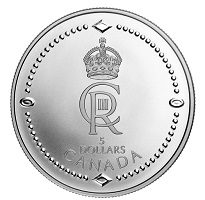
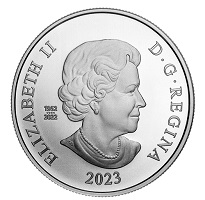
Face Value: $5 … Composition: 99.99% pure silver; Mintage: 25,000; Weight: 7.96 g; Diameter: 27 mm; Finish: Matte Proof; Edge: Serrated; Artist: RCM engravers (reverse), Susanna Blunt (obverse); Packaging: Gift set folder with removable capsule.
DID YOU KNOW? … *** The coronation ceremony involves six key rituals: the rite of recognition; the swearing of the coronation oath; the anointing with holy oil; the investiture and crowning (with St. Edward’s Crown); the enthroning; and the homage. *** Cyphers have been used by British monarchs since the reign of Henry VIII. For her cypher, Queen Elizabeth II favoured a stylized representation of St. Edward’s Crown—the official coronation crown dating from the coronation of King Charles II in 1661. His Majesty The King’s Royal Cypher features a stylized Tudor Crown, the headpiece used by monarchs until the English Civil Wars (1642-1651) and depicted in the royal cypher of His Majesty’s grandfather, King George VI.
Your coin’s reverse design features the Royal Cypher of His Majesty King Charles III. Paired with his regnal number (“III”), the initials “C” and “R” stand for “Charles” and “Rex” (the Latin word for “King”). The stylized crown in His Majesty’s cypher is a representation of the Tudor Crown, which inspired the four gemstone shapes and the engraved pearls that run along the coin’s edge. The obverse features the effigy of Queen Elizabeth II by Susanna Blunt. The obverse also bears a special marking that includes four pearls symbolizing the four effigies that have graced Canadian coins and the double date of her reign.


$10 Pure Gold Coin –
His Majesty King Charles III’s Royal Cypher
www.mint.ca
The Coronation of His Majesty King Charles III on May 6, 2023 is a momentous occasion as it marks the first coronation of a new Sovereign of Canada in seven decades. The formal investiture of the monarch’s regal power is a spectacle like no other — one steeped in pomp, pageantry and centuries-old traditions that connect the past and future. Culminating in the religious ceremony held at Westminster Abbey in London (United Kingdom), the Coronation of His Majesty The King is both a solemn and celebratory event that will long be remembered, and it is commemorated through the Royal Cypher appearing on this 1/20 oz. 99.99% pure gold coin.
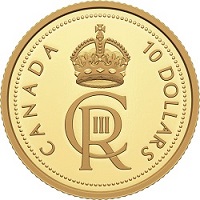
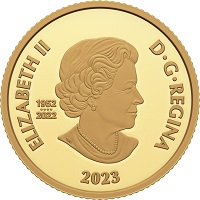
Face Value: $10 … Composition: 99.99% pure gold; Mintage: 6,500; Weight: 1.58 g; Diameter: 14.1 mm; Finish: Proof; Edge: Serrated; Artist: RCM engravers (reverse), Susanna Blunt (obverse); Packaging: Black clamshell with graphic beauty box.
DID YOU KNOW? … *** The coronation ceremony involves six key rituals: the rite of recognition; the swearing of the coronation oath; the anointing with holy oil; the investiture and crowning (with St. Edward’s Crown); the enthroning; and the homage. *** Cyphers have been used by British monarchs since the reign of Henry VIII. For her cypher, Queen Elizabeth II favoured a stylized representation of St. Edward’s Crown—the official coronation crown dating from the coronation of King Charles II in 1661. His Majesty The King’s Royal Cypher features a stylized Tudor Crown, the headpiece used by monarchs until the English Civil Wars (1642-1651) and depicted in the royal cypher of His Majesty’s grandfather, King George VI.
Your coin’s reverse design features the Royal Cypher of His Majesty King Charles III with a beaded border. Paired with his regnal number “III”, the initials “C” and “R” stand for “Charles” and “Rex” (the Latin word for “King”), while the stylized crown is a representation of the Tudor Crown. The obverse features the effigy of Queen Elizabeth II by Susanna Blunt. The obverse also bears a special marking that includes four pearls symbolizing the four effigies that have graced Canadian coins and the double date of her reign.


2024 … $15 Pure Silver Coin –
Lunar Year of the Dragon
www.mint.ca
Coin #3 in the fine silver Lunar Year series! Inspired by Chinese folk art, the whimsical Dragon on this fine silver coin’s reverse is quietly confident and clever—a beautiful representation of the traits associated with those born in the year of the Wood Dragon. The natural leader of the Chinese Zodiac, the Dragon symbolizes strength and fortune. It is known for its ability to make things happen when it focuses its energy, and in a year associated with the Wood element, there is the potential for groundbreaking ideas that bring progress and prosperity.
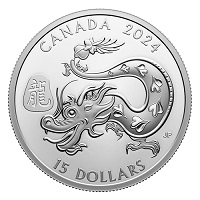
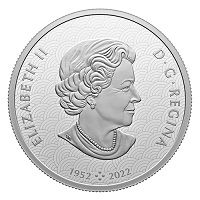
Face Value: 15 dollars … Composition: 99.99% pure silver; Mintage: 28,888; Weight: 31.39 g; Diameter: 38 mm; Edge: Serrated; Finish: Proof; Artist: Jai Paek (reverse), Susanna Blunt (obverse); Packaging: Black clamshell with red beauty box.
DID YOU KNOW? … *** Years of the Dragon: According to the Chinese Zodiac, you’re a Dragon if you were born in 1928, 1940, 1952, 1964, 1976, 1988, 2000, 2012 or 2024. Already the most auspicious animal sign, Dragons can further boost their luck by sticking with the numbers 1, 6 and 7, or their lucky colours of gold, white and grey. *** Dragons are natural leaders and go-getters. Courageous and intelligent, Dragons are not afraid of challenges and are willing to take risks. The Dragon itself has long been a revered symbol of Chinese culture; it represents power, excellence and good luck. *** Wood dragons are quiet, creative thinkers. In Chinese astrology, every year in the 12-year cycle is ruled by a different Zodiac sign and each creature is associated with one of the five elements, meaning the Wood Dragon is only celebrated once every 60 years. While Dragons are known to be fierce, driven and loyal, the Wood element in 2024 tempers their fiery, energetic temperament. Wood Dragons are calmer and more introverted, creative and inquisitive—they’ll dive into any problem, and they usually come up with an innovative idea or solution.
Inspired by traditional Chinese folk art, the reverse design by Canadian artist Jai Paek celebrates the Year of the Wood Dragon (2024) through its whimsical depiction of a Dragon (“龍”). The courageous and clever Dragon bears a playful expression as it snakes across the coin, with its head facing West and its tail facing East. The lucky number seven (7), which is associated with harmony, is represented by the Dragon’s seven heart-shaped scales that symbolize good luck and prosperity. The reverse also includes the word “CANADA”, the year “2024” and a face value of “15 DOLLARS”. The obverse features the effigy of Queen Elizabeth II by Susanna Blunt with a repeating scallop pattern. The obverse also bears a special marking that includes four pearls symbolizing the four effigies that have graced Canadian coins and the double date of her reign.
Jai Paek, Artist … “The Dragon, a mystical creature, is said to embody all the divine traits a person can aspire to in a lifetime: strength, endurance, indestructibility, wisdom and grace. As a father and designer, I choose which of these qualities I hone and indulge in, and pass on to my kin in an effort to shape them into strong, determined and compassionate human beings who will marvel at and protect the beauty of our planet. The Wood Dragon borrows its unique qualities from the strong, yet flexible material itself; its warmth, generosity, co-operation and idealism make him an outgoing and socially conscious seeker of infinite growth and expansion.”


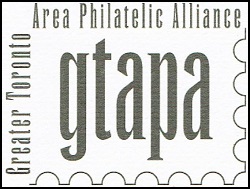
www.gtapa.org
The GTAPA is committed to promote and stimulate
the art of philately to all ages for fun,
culture, education and friendship.




